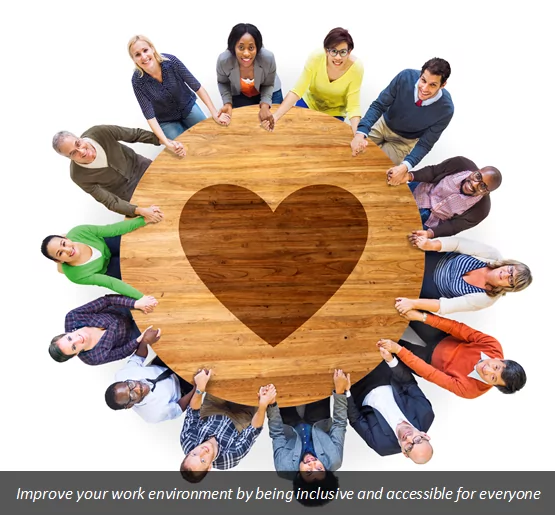Diversity in the Workplace: Part I

In this post, the first of three posts on diversity in the workplace, we examine strategies for creating a workplace that is both accessible and welcoming to coworkers who identify as Deaf, deaf or hard of hearing.
Millions of individuals across the US identify as Deaf, deaf or hard of hearing and today, there are more people than ever before in the workforce who fall into one of these categories. Two factors account for the growing number of workers who identify as Deaf, deaf or hard of hearing. Historically, many deaf people faced major obstacles obtaining employment because they were often unable to access higher education and because most workplaces were unprepared to accommodate deaf coworkers. Since the 1970s, progressive legislation, such as the American with Disabilities Act, has changed the education and employment landscape for deaf people, opening up new opportunities for deaf people to gain graduate and professional degrees and to work in a wide range of work environments alongside hearing colleagues. Second, as the population and workforce ages, a growing number of workers are also experiencing hearing loss later in their careers.

Terminology: Deaf, deaf or Hard of Hearing?
As observed above, in this article, three terms are being use—“Deaf,” “deaf” and “hard of hearing”—while several other common terms, such as “hearing impaired”, are being avoided. The difference between these terms is important. While most hearing people think about deafness as a disability, many Deaf people disagree. Rather than view deafness as a disability—something that needs to be corrected through a medical intervention—a growing number of Deaf people consider deafness a distinct culture (more akin to an ethnicity than to an impairment). While this may come as a surprise, an investigation into Deaf culture quickly reveals that Deaf people not only have their own language, which is every bit as complex as English, German, Spanish or Mandarin, but also have their own literary traditions, performing arts and politics. Deaf, with a capital D, is adopted by Deaf people who identify with the Deaf community, its culture and its political struggles. By contrast, deaf, with a lower-case d, is typically used to identify deaf people who are not part of the Deaf community per se or do not think about deafness as a unique culture. On the other end of the spectrum, there are people who identify as hard of hearing. Hard of hearing is a term most often used to identify individuals whose hearing has declined over time due to age, or for any other reason, and who more or less continue to identify with the hearing world.
The Uh Oh Syndrome discusses how individuals react and respond to those who sound, act and look different from them.
Accessibility
Making one’s work environment accessible to colleagues and clients who identify as Deaf, deaf or hard of hearing is not difficult, but it does require some planning and restructuring.
Communication Options: If you have a Deaf coworker or client, they have the right to communicate with you in their own language—American Sign Language. Unless everyone in your organization is fluent in ASL, this means having a interpreter on hand at all times or at least as requested (e.g., during meetings). For some day to day communications, however, a Deaf coworker or client may prefer other options. For example, Video Relay Services (VRS) enable Deaf people to hold telephone conversations with hearing colleagues via an interpreter. Digital communications, such as email and text messaging, are also options. That said, don’t expect a Deaf colleague to only communicate in via email or text messages. After all, you would never expect this from a hearing colleague.
Accessibility Audits: Whether or not your organization has any Deaf, deaf or hard of hearing coworkers, it is important to carry out an accessibility audit. An audit will determine whether or not your workplace is safe (e.g., if your security alarms, fire alarms and carbon monoxide detectors rely only auditory signals, they will need to be equipped with visual signals). An audit can also identify barriers that may not be as obvious. For example, many office designs amplify background noise, which poses a major barrier to hard of hearing coworkers. An audit can identify ways to redesign an workplace to help individuals with reduced hearing hear more clearly, especially during meetings. The goal of an audit, however, should be to create a workplace that adheres to the principles of Universal Design, which strives to design public and private spaces that are accessible to everyone.
Education and Training
Understanding the needs of Deaf, deaf and hard of hearing coworkers and clients is complex. After all, the Deaf and hard of hearing are two separate groups with separate needs. Likewise, Deaf and deaf individuals frequently have very different needs and perspectives on deafness that need to be taken into account. In short, the Deaf community is extremely diverse. Education and training, then, are an essential part of making one’s organization accessible to Deaf, deaf and hard of hearing colleagues. As a first step, organizations should reach out to Deaf organizations, such as the National Association of the Deaf (NAD), to arrange for an awareness workshop.